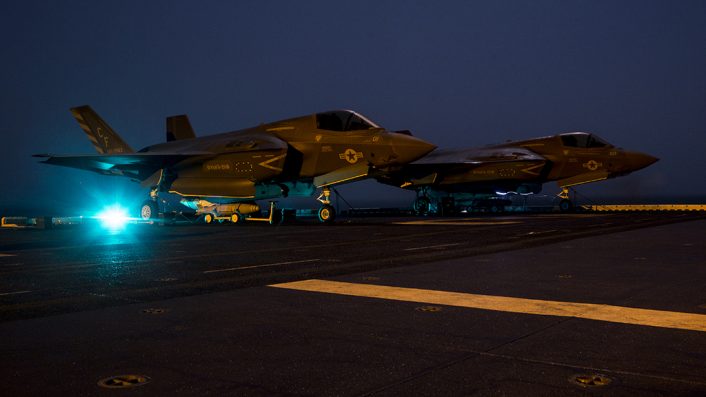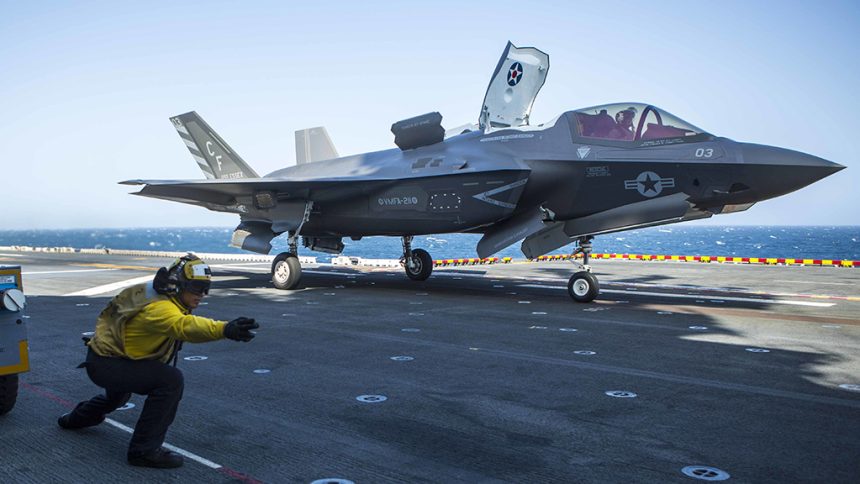U.S. Marine Corps F-35B Lightings Of VMFA-211 Hit Targets in Afghanistan From USS Essex.
For the first time in history U.S. F-35 Joint Strike Fighters flew in combat on Sept. 27, 2018. Official U.S military sources characterized the mission as “successful”.
U.S. Marine Fighter Attack Squadron 211, the “Wake Island Avengers”, of the 13th Marine Expeditionary Unit, used their F-35B Lighting II Joint Strike Fighters to hit insurgent targets in Afghanistan’s Kandahar Province early Thursday morning.
The long-range strikes were launched from the U.S. Navy Wasp-class amphibious assault ship USS Essex (LHD-2) on station in the Persian Gulf. The USS Essex recently transited the Gulf of Aden as it sailed through the North Arabian Sea and finally to combat stations in the Persian Gulf where today’s historic first-ever long range strikes were launched.
The Israeli Air Force was the first in the world to employ the F-35 Lightning II Joint Strike Fighter in combat earlier this year when they used their F-35I Adir aircraft to hit undisclosed targets at least twice.While the Joint Strike Fighter program has advanced since 2006 without a major in-flight mishap or loss of life and established numerous technical milestones it has been the focus of intense criticism due to costs and perceived delays.
Today’s U.S. Marine F-35B Lightning II strikes may either begin to temper criticism of the overall F-35 Joint Strike Fighter program or increase it even more. Indeed, while it represents the baptism of fire for the American 5th generation multirole aircraft in the STOVL variant, it also raises questions. Among them, the most obvious is: was a stealth aircraft, the most expensive defense program in history, required to hit Taliban targets in Afghanistan?
Thursday’s historic U.S. Marine F-35B Lightning II mission was “in support of ground clearance operations” according to a report in the Military Times by defense experts Tara Copp and Valerie Insinna released just hours ago.
The U.S. Marine Corps was the first military service in the world to integrate the F-35 Joint Strike Fighter into operational service during 2015. Of the three U.S. versions of the Lockheed Martin F-35 Joint Strike Fighter, the U.S. Marine F-35B Lightning II is the most complex, using an innovative vectored thrust and lift-fan configuration to take off from a ship’s flight deck without a catapult in a short distance and land back on board vertically from a hover. U.S. Marine F-35Bs used in the strikes today were also equipped with the externally mounted GAU-22 25mm gun pod in addition to the weapons in the internal bays.
The photos released by the DoD, show the F-35B being prepared for the first air strike with what seems to be a GBU-32 1000-lb JDAM (Joint Direct Attack Munitions) under the weapon bay.

By contrast to the U.S. Marine F-35B Lightning II, the U.S. Navy uses a version of the Joint Strike Fighter called the F-35C with wider wings and different landing gear to facilitate catapult launches and arrestor hook recoveries onboard U.S. Navy aircraft carriers. The U.S. Air Force flies the F-35A Lightning II, a conventional take-off and landing aircraft that flies from land based runways. While the U.S. Air Force has declared their F-35A Lightning IIs as operational the U.S. Navy is still in the final implementation phase of their wide-winged F-35C Lightning IIs.
U.S. Naval Forces Central Command Commander Vice Admiral Scott Stearney told reporters that, “The F-35B is a significant enhancement in theater amphibious and air warfighting capability, operational flexibility, and tactical supremacy,” The Vice Admiral went on to say, “As part of the Essex Amphibious Ready Group, this platform supports operations on the ground from international waters, all while enabling maritime superiority that enhances stability and security.”









